#or antients in general
Explore tagged Tumblr posts
Photo
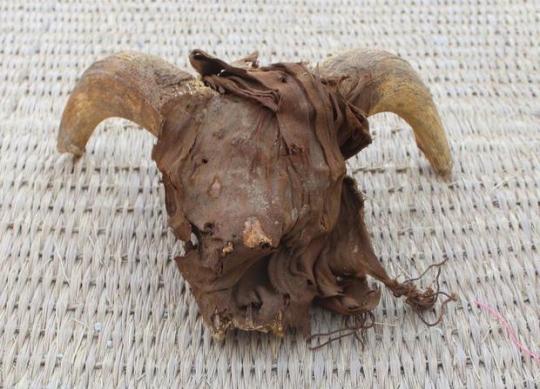
Over 2,000 Ram Skulls Discovered in Egypt's Temple of Ramses II
Cairo — Archaeologists have announced the discovery of more than 2,000 rams' heads at the temple of the ancient Egyptian pharaoh Ramses II — a find that the man in charge of the dig said surprised even veteran Egyptologists and showed the endurance of Ramses' impact, as the skulls were left there a millennium after the pharaoh's rule.
A team of archaeologists with New York University's Institute for the Study of the Ancient World (ISAW) made the discovery in the city of Abydos, one of the oldest cities and richest archaeological sites in Egypt. It's located about seven miles west of the Nile River in Upper Egypt, some 270 miles south of Cairo.
The ram skulls were found stacked in the northern precinct of the temple, said Egypt's Ministry of Tourism and Antiquities, which announced the discovery on Saturday.
"We came across some random pieces of skulls first," Dr. Sameh Iskander, head of the ISAW mission, told CBS News. "We didn't know what they were, but as we continued our excavation and exploration, all of sudden we found a whole area filled with ram skulls."

"These are obviously offerings that were made to the temple of Ramses during the Ptolomaic period, which shows even 1,000 years after Ramses II, that he was still revered." Ramses II ruled over ancient Egypt for about 60 years before his death in 1213 BC.
Iskander explained that some of the ram heads were still mummified, while "others could have been mummified but the wrappings or the covers of mummifications were not there anymore."
The skulls were found among other objects, from papyrus to leather artifacts and statues, about six feet under the contemporary surface of the desert in what had been a storeroom of the ancient temple.
The large number of skulls found in the same place was "surprising even for Egyptologists," Iskander said.

"We are sure they were all dumped at the same time, so this was not an accumulation of skulls that were brought in over the years, but they came from somewhere else and were dumped into this magazine at some point for some reason which we don't know yet," he told CBS News. "It is significant because this place where they ended up is not just any place in the temple, so they were brought there for a reason. They were not just dumped in the desert but were inside this revered domain of the temple."
The archeologists also unearthed a large structure made of mudbricks with walls about 16 feet thick dating back about 4,200 years, to ancient Egypt's Sixth Dynasty.
"It is a major structure that will change our concept of the landscape of Abydos. This wall was built for something, it was at least 30 feet high." Iskander said. "We don't know exactly what this wall is. It's possible that this was a wall of the antient Abydos, which was never found. Could it be something else? Maybe, that's what we are working on now."

The mission also found other mummified animal remains, including dogs, goats, cows and gazelles.
Beside the massive structure, one very small object also captured Iskandar's attention.
"We also found a small bronze bell in excellent condition with the clapper, so we can hear the same sound of the ancient time. I was very happy to find it," he said. "It was probably used to mark a herd."
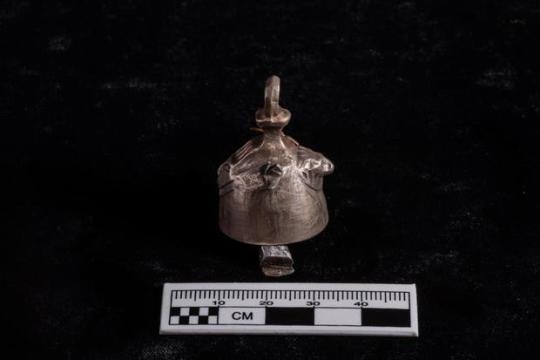
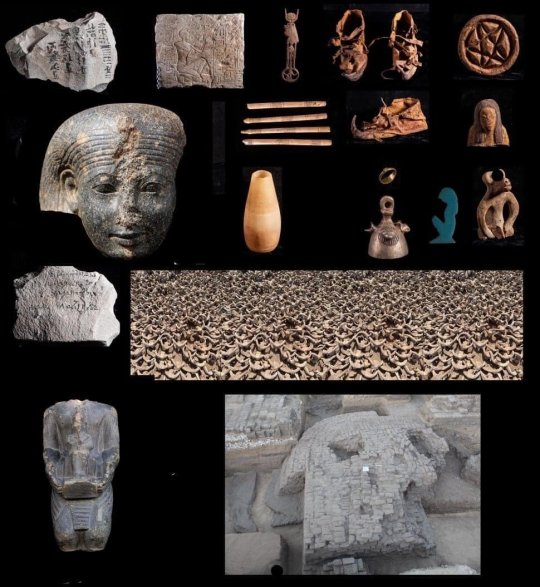
The head of the American mission, whose team has worked at the Abydos site since 2008, spoke to CBS News after traveling back to New York. He said a lot of research was still needed to find explanations for the latest discoveries.
"I hate to keep saying 'we don't know,' but this is the nature of archaeology. We keep working on findings that might lead to something, or not," he said, adding that he and his team may even need to "leave it to the next generation — they may have a better idea or other discoveries."
"Every year we have lots of finds and we come back very happy with the new finds, but we also come back with a huge sack full of questions," he said.
By Ahmed Shawkat.
#Over 2000 Ram Skulls Discovered in Egypt's Temple of Ramses II#city of Abydos#Ptolomaic period#archeology#archeolgst#ancient artifacts#history#history news#ancient history#ancient culture#ancient civilizations#ancient egypt#egyptian history#long reads
175 notes
·
View notes
Note
My gf is doing a research project on sixteenth century recipe books (building a tool to help people read/understand them) and this weekend she was telling me about an ingredient that showed up in one of them that she could not figure out what it was. I have read the soap post (which is SO COOL, btw, I am so excited to see how the wash balls turn out) and I’m wondering if you might know what it actually is.
She first saw it written as venus bolearmonack, but we found several different spellings for it when we both went down internet rabbit holes: bolearmonack, bolarmonack, bolarmonicke. We think it’s maybe some sort of dirt or clay? But it keeps bothering me that we couldn’t figure it out, and reading your post made me wonder if you would know.
OKAY SO:
From Charas's The Royal Pharmacopœea, we know that:
By Minerals I understand all Metals, Half-metals, and what belongs to Metals. All sorts of Earths, and Bole-Armoniack; all Stones, Marbles, Flints, Porphyries, Jaspers, Chrystals, Jacinths, Emraulds, Saphirs, Granats, Blood-stones, Diamonds, and all sorts of Jewels: Sulphurs, Vitriols, Allums, Sal Gem, Bay-salt, Water, Rain, Snow, Ice, Hail, Thunder-bolts, Dew, Manna of several sorts, Morter, Lime, Brick, Oyl of Naphta Amber-griece white and yellow; Jet, Sea-coal and all Bitumens. Talk, Chalk, Bismuth, Zink, and all Marcasites, the ordinary Earth, Sand, Clay; and in general whatever is drawn out of the Bowels of the Earth, or Sea; or descends from the Air, being without Life.
This is Moyse Charas telling us what a shorthand (Minerals) means -- so apparently, Bole-Armoniack (another spelling!) wasn't a shorthand for something else the way, say, "the four greater Cold seeds" are. I also included the full paragraph because that also gives a hint as to what Bole-Armoniack isn't -- or at least, they didn't think it was... which means nope, not clay or dirt.
Later we find out in the same book that it's something you gotta crush the shit outta in a mortar before you can use it, but when you do it'll reduce to an extremely fine powder the way precious stones and amber will.
Lémery's A Course of Chemistry clarifies for a recipe for, ta da, gonorrhea, that:
Litharge, which is a Lead Calcined [a heated lead], Alom, and Bole-Armenick, are so many considerable Astringents, that do no hurt in this composition.
Which is to say, bole-armenick (ANOTHER SPELLING), when powdered, can be heated up to be used in this mix and was added because it was thought to draw together or contract skin tissue. It's also interesting that Lémery bothered to define litharge (which is fairly common in recipes I've seen), but, again, not the bole-armenick.
Finally, on a hunch, I did a search for just "armenick", and hit enough paydirt that I suspect y'all can dig further using it to confirm the results-- Pettus's 1683 glossary supplement to Ercker's Fleta Minor lists the following:
ARMENICK▪ See Armoniack.
ARMONIACK, T. gives it the Latine Name, Bolus Armeni, and we Bole Armoniack, and I find these words of kin, both in their Orthography and Pronuntiation, viz. Amoniack Armenick and Armoniack. The first Pliny tell us, is a Gum which he calls Gumma Amoniaci, of a glutinous nature (like other Gums) and so may be used for Metallick Vessels. The second viz. Armenick; I find the word Sal always joyned with it, and so called Sal Armenicus, and this Salt was antiently accounted a natural Salt, but that being now unknown to us, we use the Armenicus, which is made of the Urine of Elephants or Camels (as 'tis said) boyled to a Lixivium or Salt, and called Sal Armenius or Armeniacus, and this is of great use for purifying and refining of Metals. To the third Armoniacus the word Bole is added, I suppose for distinction sake: Pliny, c. 35. mentions a Stone, which he calls Lapis Armeni, of which he counts several sorts, but the best of those he saith, are of a blew colour, and calls it verd de Azure (being of great price and esteem with Painters, but the common Armoniack he calls Synoper (and we Synople) from a City of that name, where it was plentiful, and 'tis probable this is the same which we call Bole Armoniack, being of a reddish colour, and this is oft used by our Author, and for distinction the word Gum is put to the first, Salt to the other, and Bolus to this: which I write to prevent Errors in Medicines or Metallick Experiments.
So with Pettus's definitions, triangulated with Charas's shorthand notes and Lémery's preparation instructions, we arrive at your "venus bolearmonack" probably being sinople, a "ferruginous quartz that is blood-red or brownish red sometimes with a tinge of yellow" which "occurs in small but very perfect crystals, and in masses that resemble some varieties of jasper."
All that being said, though: always try and get at least one other source to confirm a definition. My beloved Simon Barbe says that benzoin is also myrrh, and that's... that's not right, babe. So double-check, but-- here's a reasonable direction!
39 notes
·
View notes
Text

FEATHER IN YOUR CAP
Idiomatic Meaning: An achievement or special honor that one can be proud of; achieve something noteworthy or accomplish a significant feat, like graduating from college or getting a major promotion at work. It’s meant to be a symbol of achievement or recognition.
Literal Meaning: Wearing some kind of decorative plumage in one’s hat or cap.
Usage: Formal andinformal, spoken or written, general British and American English. “Feather in your hat”, is a less common alternative.
Origin: 16th Century – British and American English – This expression has historical roots and first appeared in print in the English language in Richard Hansard’s “Description of Hungary” in 1599. He wrote, “It hath been an antient custom among them [Hungarians] that none should wear a fether but he who had killed an [enemy], to whom onlie yt was lawful to shew the number of his slaine enemys by the number of fethers in his cappe.” It was a common practice to award a feather to a soldier who had shown bravery on the battlefield or achieved a significant accomplishment. This practice can be found in many cultures around the world, including knights of old who were awarded plumes for their helmets, and American Indians who were awarded feathers for their headdress for slaying their enemies.
Why is this funny? In the photo, we see an elderly gentleman dressed in an old fashioned, ethnic suit commonly worn in central Europe, say Switzerland, Austria or Hungary. He has just won two Academy Awards, though we do not know for what. Nevertheless, to win two Oscars in one night is an extraordinary feat. It was a real “feather in his cap” and so was the actual feather in his hat/cap!
Sample Sentence: When they made our daughter class valedictorian it was a real “feather in her cap”.
6 notes
·
View notes
Text
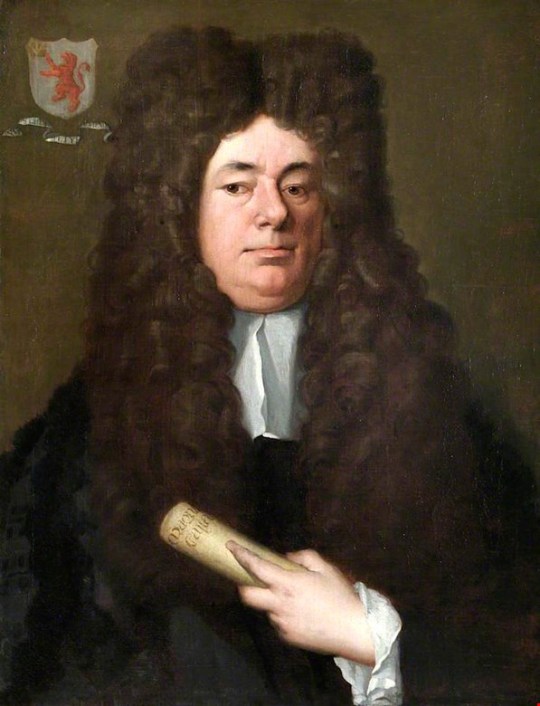
Richard van Bleeck - William Petyt Holding a Copy of the Magna Carta - c 1690
oil on canvas, height: 74 cm (29.1 in); width: 60 cm (23.6 in)
Tower of London, UK
William Petyt (or Petit) (1640/1641 – 3 October 1707) was an English barrister and writer, and a political propagandist in the Whig interest.
Petyt was born in 1640 or 1641 in the village of Storiths, near Bolton Abbey, Skipton, Yorkshire, and educated at the Free Grammar School (now Ermysted's Grammar School), Skipton, and Christ's College, Cambridge. He was admitted as a barrister to the Middle Temple in June 1660, and to Barnard's Inn in June 1661. He was specially admitted to the Inner Temple on 25 November 1664, and subsequently called to the Bar there in February 1671 and made a bencher in 1689. He served as Treasurer (that is, the head) of Inner Temple in 1701–1702.
On 25 July 1689, Petyt was appointed Keeper of the records at the Tower of London by William III, replacing in that position Robert Brady who had made a very effective attack for the Tories on Petyt's The Antient Right of the Commons of England Asserted (1680).[6] Petyt was attacked also from his own side, the Whigs, by Thomas Hunt.
Petyt wrote against the separation of powers, and in favour of Parliament's control of the judiciary. Influential in its time, in particular on John Locke, was a version of "ancient constitutionalism" propounded in the writings of John Sadler, James Tyrrell and Petyt.
Petyt died unmarried in Chelsea, London, on 3 October 1707, and was buried in the west part of Temple Church. In his will he left £50 to the Free Grammar School in Skipton which was used to purchase books for needy students. He also left £200 for the maintenance of alumni of the Free Grammar School who had been admitted as scholars at Christ's College, Cambridge. In addition, he entrusted to his trustees his books and manuscripts together with £150 for buying or building a place to preserve them. Inner Temple Library was enlarged for this purpose, and in 1708 Petyt's trustees deposited his collection there, except for about 2,000 items which his brother Sylvester (1640–1719) took to his home in Yorkshire. Sylvester, who also attended the Free Grammar School, eventually bequeathed to the school the generous sum of £30,000 to form the Petyt Trust, and also books belonging to himself, his brother and friends which became the Petyt Library.
Richard van Bleeck (1670–1733) was a Dutch Golden Age painter.
14 notes
·
View notes
Text

The materials, of which I purpose to make use in the following inquiries, are comparatively few, and will be contained within a small compass. They are such as are to be found in the composition of most names, which occur in antient mythology: whether they relate to Deities then reverenced; or to the places, where their worship was introduced. But they appear no where so plainly, as in the names of those places, which were situated in Babylonia and Egypt. From these parts they were, in process of time, transferred to countries far remote; beyond the Ganges eastward, and to the utmost bounds of the Mediterranean west; wherever the sons of Ham under their various denominations either settled or traded. For I have mentioned that this people were great adventurers; and began an extensive commerce in very early times. They got footing in many parts; where they founded cities, which were famous in their day. They likewise erected towers and temples: and upon headlands and promontories they raised pillars for sea-marks to direct them in their perilous expeditions. All these were denominated from circumstances, that had some reference to the religion, which this people professed; and to the ancestors, whence they sprung. The Deity, which they originally worshipped, was the Sun. But they soon conferred his titles upon some of their ancestors: whence arose a mixed worship. They particularly deified the great Patriarch, who was the head of their line; and worshipped him as the fountain of light: making the Sun only an emblem of his influence and power. They called him Bal, and Baal: and there were others of their ancestry joined with him, whom they styled the Baalim. Chus was one of these: and this idolatry began among his sons. In respect then to the names, which this people, in process of time, conferred either upon the Deities they worshipped, or upon the cities, which they founded; we shall find them to be generally made up of some original terms for a basis, such as Ham, Cham, and Chus: or else of the titles, with which those personages were, in process of time, honoured. These were Thoth, Men or Menes, Ab, El, Aur, Ait, Ees or Ish, On, Bel, Cohen, Keren, Ad, Adon, Ob, Oph, Apha, Uch, Melech, Anac, Sar, Sama, Samaïm. We must likewise take notice of those common names, by which places are distinguished, such as Kir, Caer, Kiriath, Carta, Air, Col, Cala, Beth, Ai, Ain, Caph, and Cephas. Lastly are to be inserted the particles Al and Pi; which were in use among the antient Egyptians.
2 notes
·
View notes
Text
Transcript of the first page:
So, the Freemasons exist to this day and you are more than welcome to contribute to what I found about them. I am no member of them myself and as all clubs back in the day, much information on them is vague. Maybe not as bad as with the Knight's Templars, yet the library still has only bits and pieces on them.
I tried drawing their ideals in a chart: above all comes self-knowledge. From this, it spawns humanity, tolerance, freedom, equiety and brotherhood, all nice values even to this day. The Freemasons were a fraternal organizations meaning only men could participate (since women were viewed as "too stupid" to think; today, they allow women too). As with all non-Christian organizations in very Christian countries they were depicted as evil, world-domineering people who want to enslave the rest of the world. They funnily had only two goals away from the rumors:
spread the Rennaissance-Thinking named Aufklärung
spread knowledge and not belief.
Freemasonry follows no religious dogma, it needs no set religion to join and anyone can join them. Their symbol is a tool to measure just like they try to measure the world and not believe it.

Transcript of the second and third and page:
Left is a scan of the structure of the Freemasons. It's a bit complicated and I didn't get much, but here's what's important to me: people have masonic degrees as seen on the lower right side of the drawing. They go through a lot of stages until they reach the Supreme Council and are called Sovereign Grand Inspector General. They even had a separate orders for women (like the "Amarath" or "Daughter of the Nile") and for younger members like "Job's Daughters".
What they all have in common is they beleive in a "Great architect of the universe" in a metaphorical sense, not as a god. Each member has a different kind of architect in them and can enrich life as they wish. Their members were all over the place when looking at status, ethnicity or religion. They were strong advocates of separating the state from religion and held their meetings in private so that their members were safe.


Transcript of the fourth and fifth and page:
The ideals mentioned on the first page have a bit more behind them.
Freedom: getting rid of any kind of oppression and slavery
Equiety: all men are equal and classes need to be abolished
Brotherhood: within the members, shall be aquired by trust, care, safety, responsibility and talk to others
Tolerance: by actively listening to others and (trying) to understand their view
Humanity: is all of the above, symbolized by the "Temple of Humanity". Here's the ties to the Templars who worshipped the Temple of Salomon, where their headquaters were.
I also tried to make a timeline of them- of course a lot is missing, yet I tried to compromise with things still making sense.



Transcript of the sixth page:
Middle ages: Freemasons are created, we don't know why or how. Speculation says it had been started by masons building cathedrals and churches.
1646: The first documented invitation to the Freemasons in Warrington, Lancashire.
1660: More evidence of men taking part in non-open Lodges, that's the name of their meeting rooms.
1717: The election of the first Grand Lodge's Grand Master takes place and four small Lodges fusion.
1723: The first book woth rules comes up, "The Book of Constitutions of Masonry". Meetings are being recorded now.
1736: Freemasons were sent to the British empires overseas int he 17th and 18th century to spread their ideas.
1751: The first Grand Lodge opens in London, they call themselves "The Antients".
1800: The first meeting in Cape Town, South Africa, takes place.
1811: The first permanent Lodges were established, warranted by the Grand Lodge of England.
1813-1816: the Lodges continued to merge together.


So, what did we learn today? No one mentions the LV, Paris or the Monstrum, Paris is still in panic and I'm not sure if Freemasons exist to this day. I'll have a look.
Oh, and I hope my mail will get answered by Carvier soon, it's been a few days already...
#tomb raider angel of darkness#traod#classic tr#tomb raider#angel of darkness#journal#aod#lara craft#tomb raider series
2 notes
·
View notes
Text
MESSERS. PRINTERS,
I observed on one of the drums belonging to the marines now raising, there was painted a Rattle-Snake, with this modest motto under it, “Don’t tread on me.” As I know it is the custom to have some device on the arms of every country, I supposed this may have been intended for the arms of America; and as I have nothing to do with public affairs, and as my time is perfectly my own, in order to divert an idle hour, I sat down to guess what could have been intended by this uncommon device—I took care, however, to consult on this occasion a person who is acquainted with heraldry, from whom I learned, that it is a rule among the learned in that science “That the worthy properties of the animal, in the crest-born, shall be considered,” and, “That the base ones cannot have been intended;” he likewise informed me that the antients considered the serpent as an emblem of wisdom, and in a certain attitude of endless duration—both which circumstances I suppose may have been had in view.—Having gained this intelligence, and recollecting that countries are sometimes represented by animals peculiar to them, it occured to me that the Rattle-Snake is found in no other quarter of the world besides America, and may therefore have been chosen, on that account, to represent her.
But then “the worthy properties” of a Snake I judged would be hard to point out This rather raised than suppressed my curiosity, and having frequently seen the Rattle-Snake, I ran over in my mind every property by which she was distinguished, not only from other animals, but from those of the same genus or class of animals, endeavouring to fix some meaning to each, not wholly inconsistent with common sense.
I recollected that her eye excelled in brightness, that of any other animal, and that she has no eye-lids She may therefore be esteemed an emblem of vigilance. She never begins an attack, nor, when once engaged, ever surrenders: She is therefore an emblem of magnanimity and true courage. As if anxious to prevent all pretentions of quarrelling with her, the weapons with which nature has furnished her, she conceals in the roof of her mouth, so that, to those who are unacquainted with her, she appears to be a most defenceless animal; and even when those weapons are shewn and extended for her defence, they appear weak and contemptible; but their wounds however small, are decisive and fatal: Conscious of this, she never wounds till she has generously given notice, even to her enemy, and cautioned him against the danger of treading on her. Was I wrong, Sir, in thinking this a strong picture of the temper and conduct of America? The poison of her teeth is the necessary means of digesting her food, and at the same time is certain destruction to her enemies—This may be understood to intimate that those things which are destructive to our enemies, may be to us not only harmless, but absolutely necessary to our existence.—I confess I was wholly at a loss what to make of the rattles, ’till I went back and counted them and found them just thirteen, exactly the number of the Colonies united in America; and I recollected too that this was the only part of the Snake which increased in numbers—Perhaps it might be only fancy, but, I conceited the painter had shewn a half formed additional rattle, which, I suppose, may have been intended to represent the province of Canada.—’Tis curious and amazing to observe how distinct and independant of each other the rattles of this animal are, and yet how firmly they are united together, so as never to be separated but by breaking them to pieces.—One of those rattles singly, is incapable of producing sound, but the ringing of thirteen together, is sufficient to alarm the boldest man living. The Rattle-Snake is solitary, and associates with her kind only when it is necessary for their preservation—In winter, the warmth of a number together will preserve their lives, while singly, they would probably perish—The power of fascination attributed to her, by a generous construction, may be understood to mean, that those who consider the liberty and blessings which America affords, and once come over to her, never afterwards leave her, but spend their lives with her.—She strongly resembles America in this, that she is beautiful in youth and her beauty increaseth with her age, “her tongue also is blue and forked as the lightning, and her abode is among impenetrable rocks.”
Having pleased myself with reflections of this kind, I communicated my sentiments to a neighbour of mine, who has a surprizing readiness at guessing at every thing which relates to publick affairs, and indeed I should be jealous of his reputation, in that way, was it not that the event constantly shews that he has guessed wrong—He instantly declared it as his sentiments, that the Congress meant to allude to Lord North’s declaration in the House of Commons, that he never would relax his measures until he had brought America to his feet, and to intimate to his Lordship, that were she brought to his feet, it would be dangerous treading on her.—But, I am positive he has guessed wrong, for I am sure the Congress would not condescend, at this time of day, to take the least notice of his Lordship in that or any other way.—In which opinion, I am determined to remain your humble servant, AN AMERICAN GUESSER.
Pennsylvania Journal, Dec. 27, 1775
~Benjamin Franklin

i think it is good to warn people in advance about the circumstances that will cause you to bite them and i think that having given that warning it is good to follow through when the time comes
315K notes
·
View notes
Text
Have i told you that forest tribes talk with trees and some of their tribes forms connections with some antient trees that provides them with shelter and memory of generations? Magic of low frequencies!
0 notes
Text
SEX
Why is sex so much prohibited in India, it makes no sense, we are the country who gave Kamasutra to the world once upon a time, almost all of our temples and antient buildings include structures of men and women is sexual positions sometimes even having sex.
Why is it so that in the right age a boy is prohibited to have sexual intercourse with a girl whom he likes, during teen-age and early adulthood only a man has the most amount of testosterone, which becomes the half of what it used to be at age 30. Boys need sex like any other life force like food, air, water, etc, it is a basic life force, it is what created us in the first place, marital or pre mareital sex stems from the caste based system which has been overthrown by the goverment and science has invented so many pregnency and disease preventing equipment's, comdoms, lubricants are the top examples, still this retarded society dosent wanna digest sex like a common thing, why do we need to make a big deal about it, sex dosent stems from lust only, it stems from love, only retarded, braain rotted people think thaT LUST is the force behind sex. In foreigh countries, the average age of loosing virginity is around 14, but only in india it is around 23.
Seamen is just like any other bodily fluid, like blood sweat tears, our body can and will always create more of it, a teenage boy has the ability to have sex upto 7 times a day, sex is a very natural thing and seamen is a very easily produced bodily fluid, its 95 percent just mucus, the same mucus which is generated in ones neck at the time of cold.
Science has time and time again proven the fact that there is no benefit of semen retention, it is senseless, and none in their right minds think about it at all, the very brain rotted people of the past created this hoax to prevent their daughters and sons from having sex as it hurtled their alter ego. We need to normalize sex and take it as a normal everyday act like any other thing.
0 notes
Text
This post made return to the codex and one more time!! GOW Ragnarok and Valhalla blowed out my mind!! Valhalla's codex literally illustrated by Kratos, well, there is a bunch of Atreus's drawings too, but mostly Kratos do it himself and it is very interesting to analyze. ___ First of all, if you didn't notice, there is Kratos's greek handwriting on his drawings
Actually, sometimes it seems just like compulsively written letters, but nope, his handwriting completely shows his character and how busy with thoughts is his head all the time, like FASTER, FASTER!1


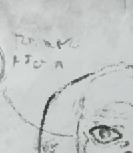
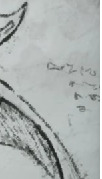

Just for comparison, here is Atreus's nordic handwriting

But let's return to Kratos's art style. His drawings are not very detailed in comparison with Atreus's and lineart is rougher and bolder, but the are very accurate anyway. Also his works are obedient to the certain rules, the more thoughts or feelings about the subject he has - the more angled geometry he put into it. Generally he draws square meanders - classic antient greek patterns, and when he draws these, he is THINKING and worrying.
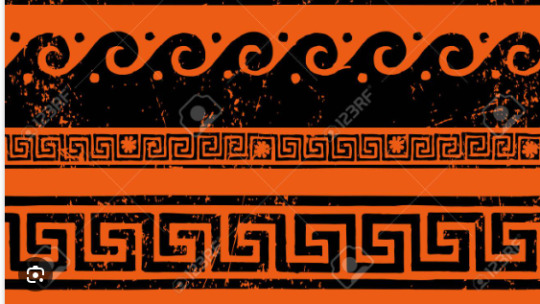
Whrn his mind is calm, his drawings are just sketchy. Nothing special besides lil single meanders here and there. Kratos rarely do shades, and even more rarely do hatching. And his drawing are not very dimensional. Raeb by Atreus - Dead legioneer by Kratos


Also Kratos doesn't draw faces and hands properly. But in Valhalla his mind is pushing to the edge and his drawings sometimes starts to shows unspoken emotional responses about the things he forsed to remember.
Let's look at Helios.. GEOMETRY AND SYMMETRY appears. Meanders (agressively?) "looks" outside, seems like he didn't want to take efforts over this (but still made these drawings good %)). Honestly, he put more precision in drawing Ares's dead soldiers than in these two pieces. Understandable. Ares's soldiers can't speak.


OKay, we all know what Kratos feels about the Olympians, and here you can see the difference in a mood Orkos's stone, first lining of stone is rough, but then refined over it with a more precise, hard, black line, and all trapped in a circle. It is the first fully complete circle he drew, and all meanders "looks" inside (autoagression maybe or just a need to calm himself with familiar patterns? maybe both).
There is very much anxiety and saddness here, oh, and by the way, that's how Kratos see himself - an uneven, blurry shadow with swirling darkness inside - a "ghost" in one word

More geometry. Pandora drawing in a big BIG meander depicting a "maze". Small meanders "looks" inside again (autoagression?/need to calm himself?/both?) Oh and he wrote her name here.. Πανδώρα This drawing is not so compulsive as the previous, more thoughtfull. His actual frustration can be seen in this big "dot" near her name. Like he wanted to write more, but changed his mind. And the lowest meanders are inverted upside down like he forgot the direction he drew them.
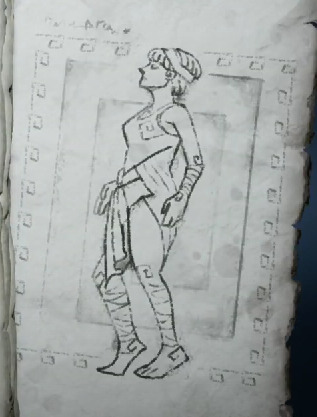
Lysandra's pendant and Calliope's flute drawings Geometry, symmetry Pendan't patterns seems more trembling, insecure as he said he feels about his wife (but I also see "heart" shapes in it). His hand is more steady at flute drawing
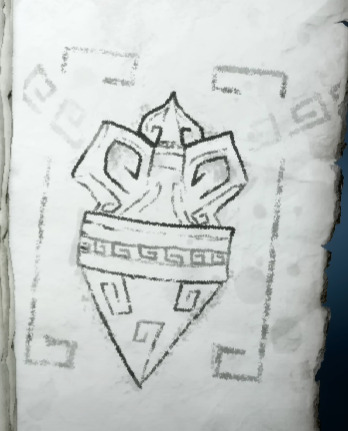
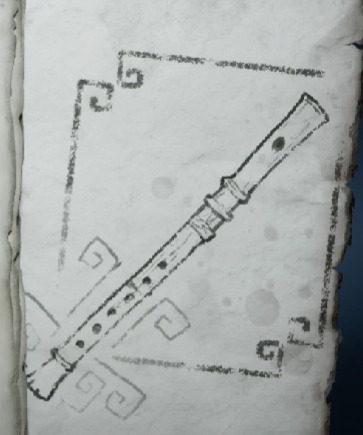
What else did I found... After reviewing Ragnarok codex wishing to compare their art style, I noticed this piece. The Lyngbakr drawing made by Aterus, with his handwritings, fine detail, his significant swirls and wait- MEANDERS? this square geometry looks very outcast here, like it were drawn over swirles and circles turned into squares.

If you look at the banch of Atreus's drawings, you'll that he just doesn't draw square patterns, only round ones like waves, and these pointed ones which looks like uh claws?.. and and very rarely - schematic runic patterns
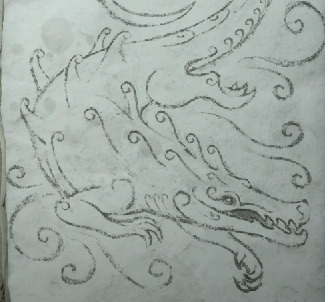
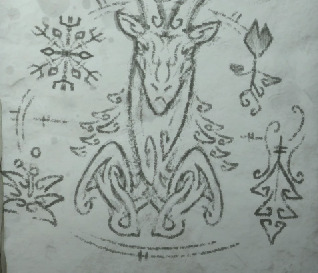

Well, if we remember, Lyngbakr's story impressed(?) Kratos very much.. Maybe Kratos returned to this pages in the codex and uh thoughtfully uh intervened in his son's drawing. %) Anyway, it was the single episode in Ragnarok codex and it can be just a coincedence, BUT THEN WE LOOK AT VALHALLA CODEX AND WHAT IS IT? Kratos is messing around with his symmetric geometry and meanders on Atreus's drawing again. He just misses his son, let's forgive him. And his scribbles are so dim like he tried to erase them..

Thinking about how Angrboda asked Atreus if Kratos draws and he laughed and said "no" but we see Kratos' journal and there are beautiful drawings of things he is describing haha
#Kratos#kratos gow#Atreus#gow#gowr#god of war ragnraok#lysandra god of war#gow calliope#god of war#god of war valhalla#god of war ragnarök: valhalla#gowr valhalla#atreus gow
354 notes
·
View notes
Text
How Virginie de La Fayette got her name
La Fayette’s and Adrienne’s forth and last child was a girl named Marie Antoinette Virginie. She was named after the State of Virginia in America and a after a Saint of the Roman Catholic Church. Here are two correspondences; one with Dr. Benjamin Franklin and one with George Washington that shed a light on La Fayette’s thought process of naming his daughter Virginie.
La Fayette wrote to Dr. Benjamin Franklin on September 17, 1782:
My Dear Sir,
Every Child of Mine that Comes to Light is a Small Addition to the Number of American Citizens. I Have the pleasure to Inform You that, tho' She Was But Seven Months Advanced, Mde. de Lafayette Has this Morning Become Mother of a Daughter Who However Delicate in Its Begining Enjoys a Perfect Health, and I Hope Will Soon Grow Equal to the Heartiest Children. (…) They Asked me What Name My Daughter is to Have. I Want to Present Her as an offering to My Western Country.
And As there is a Good Sainte By the Name of Virginie, I Was thinking if it Was not Presuming too Much to Let Her Bear a Name Similar to that of one of the United States. (…)
Franklin replied to La Fayette the same day (September 17, 1782):
Dear Sir,
(…) the News of Madm. de la Fayette's safe Delivery, and your Acquisition of a Daughter gives me Pleasure. In naming our Children I think you do well to begin with the most antient State. And as we cannot have too many of so good a Race, I hope you & Mde. de la Fayette will go thro' the Thirteen. But as that may be in the common way too severe a Task for her delicate Frame, and Children of Seven Months, may become as Strong as those of Nine, I consent to the Abridgement of Two Months for each; and I wish her to spend the Twenty-six Months so gained, in perfect Ease, Health & Pleasure. While you are proceeding, I hope our States will some of them newname themselves. Miss Virginia, Miss Carolina, & Miss Georgiana will sound prettily enough for the Girls; but Massachusetts & Connecticut, are too harsh even for the Boys, unless they were to be Savages. (…)
Next, La Fayette wrote to George Washington on October 17, 1782:
My dear General,
(…) Mde de Lafayette Begs Her Most Respectfull and Affectionate Sentiments to Be Presented to You and to Mrs Washington—she Has Born During Seven Month an Infant Who Lately Has Come to the World at this Early Period—She proved to Be a daughter, and, However delicate, Will I Hope Be Well Brought Up—I took the liberty to Call Her By The Name of Virginia. (…)
Washington replied to this letter on March 23, 1783:
My dear Marqs.
I have to acknowledge the honor of your favors of the 14th. & 24th. of October and 4th. of Decr; to thank you for the warm and affectionate expression of them; and to congratulate you & Madame La Fayette on the birth of a daughter. Virginia I am perswaded, will be pleased with the Compliment of the name; and I pray as a member of it she may live to be a blessing to her Parents. (…)
#marquis de lafayette#lafayette#la fayette#george washington#benjamin franklin#adrienne de lafayette#1782#1783#children#birth#naming#virginia#letters#french history#american history#18th century#virginie du motier#marie antoinette
20 notes
·
View notes
Photo



December 10th 1747 saw the death of Duncan Forbes of Culloden, the Lord President of the Court of Session.
Duncan Forbes of Culloden was born at Bunchrew, near Inverness, in 1685. His family later moved to Culloden House. He studied law at Edinburgh and Leiden between 1704 and 1709.
Forbes urged the creation of Highland Regiments under the command of Highlanders loyal to the King. This was to be an attempt to prevent a Jacobite Rising from taking place.
At the age of 52 he was appointed Lord President of the Court of Session and, also in 1745, became the laird of Culloden following his brother's death.
During the course of the 1745 Jacobite Rising, Bonnie Prince Charlie stayed at Culloden House several times, including the two days before the Battle of Culloden. Despite being a strong Protestant and loyalist, Duncan Forbes opposed the harsh means used after Culloden to punish and subdue the Highlanders. On hearing that trials of Jacobites would not be held in Scotland he protested and wrote to Robert Walpole, Chancellor of the Exchequer, to protest the actions and even collected money to help support the Jacobite prisoners at Carlisle.
Let's not get carried away though, although a fair minded man afterwards, Charlie thought he was such a danger he is said to have personally issued a warrant for his arrest. In October 1745 Forbes managed to hold off an attempted raid on Culloden House. Around 150-200 Jacobites surrounded the property and crept towards the building walls. As they approached though they were spotted by an alert sentry and greeted with a rally of gunfire. A small paterero, or swivel gun, was also fired from a balcony and at that point the Jacobites fled leaving behind a dead man but consoling themselves by running off all the sheep and cattle they could find. The next morning a search of the nearby woodland turned up another casualty who confessed the men had been commanded by James Fraser of Foyers and they had been sent by the supposedly neutral Lord Lovat.
On the run up to Culloden, Forbes fled North ending up on Skye where he heard about the battle He opposed the harsh means used after Culloden to punish and subdue the Highlanders, this fell on deaf ears as Cumberlands men got free reign to do what they wanted.
While Forbes argued for moderation in dealing with the defeated Jacobites, he was the main advocate and author of the Disarming Act of 1746, he wrote "What is properly called the Highlands of Scotland is that large tract of mountainous Ground to the Northwest of the Tay, where the natives speak the Irish language. The inhabitants stick close to their antient and idle way of life; retain their barbarous customs and maxims; depend generally on their chiefs as their Sovereign Lords and masters; and being accustomed to the use of Arms, and inured to hard living, are dangerous to the public peace; and must continue to be so until being deprived of Arms for some years, they forget the use of them."
Eighteen months after Culloden Forbes died. Some said he fell ill from a broken heart, with the suffering that he saw across Scotland causing him great distress. He died on 10th December 1747 and was buried in Greyfriars Kirkyard in Edinburgh. His grave is marked by a stone slab added in the 1930s by the Saltire Society.
The statue is in Parliament Hall next to St Giles on the Royal Mile, part of the High Court of Scotland.
7 notes
·
View notes
Text
This is the insightful look on Call me by your name and Alexander and Hephaestion that I didn’t know I needed it.
I had never realised it, but this makes so much sense, there really are many similarities. And I loved the Jane Eyre reference, it's one of my favourite books.
I like studying antient greece and more specifically, queer people in antient greece and antient time generally (I mean I use tumblr so that can be easily correctly assumed), and I have found that these relationships are very similar, specially on these two points: it's very intense, I mean, a "connection of a lifetime" intense type of thing, and they never end up together. Achilles and Patroclus (probs ficcional but counts), Adrian and Antinoo, Alexander and Hephaestion, and there's more.
For better or worse, these check out with Call me by your name too. I think there really is a big chance of them being inspired, at least partially, in Alexander and Hephaestion, but also just queer antient people in general. Aciman seems like a history nerd, which i think is awesome.
"Mystery of Love" by Sufjan Stevens, Elio and Oliver, and Alexander the Great and Hephaestion
I was listening to "Mystery of Love" by Sufjan Stevens from the Call Me by Your Name soundtrack today, and a particular lyric stood out to me: “Like Hephaestion, who died / Alexander’s lover / Now my riverbed has dried / Shall I find no other?” I knew little about Alexander the Great’s alleged relationship with Hephestion. Still, as I researched more, I realized how similar these real people are to Elio and Oliver, especially in the book. For example, when Hephaestion fell ill and later died, Alexander refused to eat or drink anything and cut his hair (Nat Geo), a sort of physical liberation from the memories of his past best friend and supposed lover. Alexander died a year later. When compared to the end of Call Me by Your Name, when Oliver and Elio meet one last time, and Elio says, “‘You are the only person I’d like to say goodbye to when I die, because only then will this thing I call my life make any sense. And if I should hear that you died, my life as I know it, the me who is speaking with you now, will cease to exist’” (Aciman 240). Since these instances are eerily similar, I wonder if Aciman based his characters around Alexander, who only shared his most personal version of himself with Hephaestion and Hephaestion, who listened until their time together was destined to end. This parallels with a quote from Call Me by Your Name, “I was thinking, instead, of Emily Brontë’s words: because ‘because he’s more myself than I am.’”. Another similarity I found was how people around both pairs viewed their relationship status. Historians have no concrete evidence pointing to Alexander and Hephaestion being lovers, but some think it is too unlikely to believe they weren’t. When Oliver returns to the States after his ephemeral summer as a houseguest in Italy, Elio’s father sits down to talk with him. He speaks of how special their friendship was, stating, “‘You had a beautiful friendship. Maybe more than a friendship. And I envy you' … ‘Have I spoken out of turn?’” (Aciman 224). Elio’s father studies ancient Greek statues and is a professor of archaeology. This furthers my point of the connection between these real people and Aciman’s characters, which Sufjan Stevens illustrates with the original song he wrote for the movie adaptation. There seems to be too many parallels for this to be sheer coincidence, but it is fascinating nonetheless.
Sources:
Call Me by Your Name by André Aciman.
#call me by your name#alexander the great#hephaestion#andre aciman#antient greece#queer rep in media
17 notes
·
View notes
Photo

The Deity, which they originally worshipped, was the Sun. But they soon conferred his titles upon some of their ancestors: whence arose a mixed worship. They particularly deified the great Patriarch, who was the head of their line; and worshipped him as the fountain of light: making the Sun only an emblem of his influence and power. They called him Bal, and Baal: and there were others of their ancestry joined with him, whom they styled the Baalim. Chus was one of these: and this idolatry began among his sons. In respect then to the names, which this people, in process of time, conferred either upon the Deities they worshipped, or upon the cities, which they founded; we shall find them to be generally made up of some original terms for a basis, such as Ham, Cham, and Chus: or else of the titles, with which those personages were, in process of time, honoured. These were Thoth, Men or Menes, Ab, El, Aur, Ait, Ees or Ish, On, Bel, Cohen, Keren, Ad, Adon, Ob, Oph, Apha, Uch, Melech, Anac, Sar, Sama, Samaïm. We must likewise take notice of those common names, by which places are distinguished, such as Kir, Caer, Kiriath, Carta, Air, Col, Cala, Beth, Ai, Ain, Caph, and Cephas. Lastly are to be inserted the particles Al and Pi; which were in use among the antient Egyptians.
Source:
A New System; or, an Analysis of Antient Mythology. Volume I. by Jacob Bryant
https://www.gutenberg.org/ebooks/19153
ancient mythology project gutenberg
See: https://rhianna.tumblr.com/search/sun
11 notes
·
View notes
Photo

This light reading is quite fitting, right?
A treatise concerning the plague and the pox, discovering as well the meanes how to preserve from the danger of these infectious contagions, as also how to cure those which are infected with either of them.
The antient Phisitians in times past have greatly doubted, what the essentiall cause of this disease, which we commonly call the Plague or Pestilence, should be; yet all doe agree, that it is a pernitious and contagious Fever, and reckoned to be one of the number of those which are called Epidemia, chiefly proceeding of adusted and melancholy bloud, which may be easily perceived, by the extream heat and inflammation, which inwardly they doe feel, that are infected therewith; first assaulting the heart, and astonishing the vitall spirits, as also by the exteriour Carbunkles and botches which it produceth; whose malignity is such, both in young and old, rich and poor, noble and ignoble, that using all the meanes, which by Art can, or may be devised, yet in some it will in no sort give place, untill it hath by death con∣quered the party infected therewith. (Chapter 1)
Published in 1652, this book concerns topics of what a plague is, how to treat different illnesses, a correct diet to keep, and good and evil signs of an infection. This rare book was donated by a generous book collector, Roy G. Neville, and is housed with the crème de la crème of rare books in our Edelstein Rarebook Room.
25 notes
·
View notes
Text
704. Ignore me I didn’t see anything.
This was prompted by a beautiful anon and oh boy it was fun to write XD
Fandom: Detroit become human | Ship: Reed900 (Warnings: NSFW, smuttish but not really (I went with “hardcore making out” as you put it))
Connor knew humans were very centred on tradition. Most, although stating change was good when asked, liked their routines and despised them being interrupted. Even if the decisions were rational and the changes ended in the whole process becoming more efficient and simpler, the first time living with the uncommon alteration was hated by most. Human history was full of examples: Cars instead of horses, Computer instead of paper and most recently androids as persons not as machines. Some changes were faster than others, but still, Connor couldn’t stop himself from shaking his head at this stubbornness as he descended the stairs down to the archives.
Data encryption was as advanced as it could get with AIs that generated passwords and could even scan the person that tried to access certain files. It was near impossible to hack into a secured network, except when one was some military-grade android. And the only one ever created was in this precinct and too dutiful to ever betray them. Still, the DPD kept their most important files and evidence down here in a near deserted basement. They were more likely to fall victim to mould, dust and mice than to ever see sunlight again, but well, humans had always been irrational. Thankfully they waited with the archiving until the case was closed, so only old, unsolved cases that were enrolled again needed someone to come down here.
Connor opened the door to a flickering lightbulb. Not even a LED one, a real, old lightbulb. The damn things had been banned for energy conservation thirty years ago what told a lot about how often this damn room was used. It was surprising it still worked from the long use. Someone must have forgotten to switch it off since the last time they were here. He sighed and walked through the rows of files dating back to before androids were created. These papers weren’t just older than him, what didn’t say much, but even older than some of the humans who worked here. Considering the few years he was active now, that seemed antient.
As he turned into one of the aisles, his systems warned him of some unknown noises, but Connor brushed them of as croaking shelves or the pipes that ran along the roof. He grabbed the file he was looking for confidently, thinking about nothing but the new leads they had gotten, as suddenly his audio-sensors picked up something with the prospect of being very, very disturbing. ‘Oh, Nines, best idea, ever!’ ‘I know. I have the best processors out there.’ ‘And I love every bit in them.’ Mortified Connor stood there, frozen, as what sounded like wet kisses where exchanged. It couldn’t be. This had to be some kind of hallucination, just his deviancy playing tricks on him. Maybe he was malfunctioning. Every one of these possibilities he liked more than what was reality.
He turned around and ducked down behind a shelf to find the source of the noises and spied around the corner. He could only see the back of his brother, jacket discarded. There were hands clearly visible under that slim-fit turtleneck, caressing the back of the other android. There was the white Cyberlife jacket Nines still wore and kept immaculately clean, laying in the dirt and sweaty, human hands on his body even Connor wasn’t allowed to touch unprompted. And more terrifying than that was the dawning realisation what his brother was doing and with whom.
Nines leaned down to hold Gavin’s face and kiss him – long and intense – while the human’s hands also travelled deeper and under the back of his trousers to squeeze the android’s ass. Connor had to look away, but the noises remained. Oh RA9. His brother was perhaps the most uptight android when it came to relationships and basic physical contact. Especially with humans. Connor knew he had taken a liking to the rude Detective that couldn’t speak a sentence without being offensive or obscene if his life depended on it. But to think he liked him that much…
‘I love you too, Gavin’, Nines breathed, and Connor had never heard so much emotion in his voice. ‘I couldn’t imagine…’ There were obvious pauses filled by shaky breaths of the human between kisses. ‘… the world…’ ‘… without you.’ ‘Same, dude’, was the less eloquent answer followed by a shirt being pulled open. Connor risked another look to see Nines pressing their foreheads together and both his hands on Gavin’s naked chest, most likely feeling his heartbeat and breathing.
It was as the skin receded from them and they travelled deeper, slowly prying open more buttons in the process, that Connors eyes widened, and he turned away again, pressing them together firmly while leaning against the shelf. No. Please. Connor was proud that Nines took that step and allowed himself to show and express his feelings, but Gavin? There were better androids, better humans out there. This meant someday, he would have to sit with Reed at the table, pretending to like him to not make things like the family dinner, Christmas or birthdays awkward as hell. Why, Nines, why? Oh, no, had this been a zipper? Connor opened his eyes but was seriously afraid to look around the corner again. A loud moan followed the sound of fabric gliding over skin and yes, these were definitely knees hitting the floor.
Nope.
Connor’s fight or flight response activated and to hell, it was flight. He pressed his files against his chest and hurried out of there, hoping to erase these noises forever from his memories next stasis cycle.
At least it seemed some people were more accepting to change than others.
#detroit being human#dbh#Reed900#RK900#Gavin Reed#Connor noping the phck out is now my favourite combination of words#Nines: Don't worry no one is coming down here we'll be alone#Connor: DoN'T WOrrY No ONe iS comING doWn HeRE#Also it's inaccurate because lightbulbs were only banned in europe in 2009#I fact checked#But I don't care#Sorry lightbulb fandom
56 notes
·
View notes